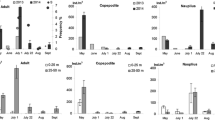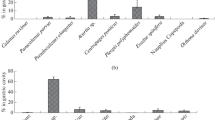Abstract
Limnocalanus macrurus is an important member of the zooplankton communities of the Siberian shelf seas. During the cruise, Boris Petrov 1999, in August/September to the southern Kara Sea and the Ob and Yenisej estuaries, its abundance and vertical distribution were investigated. In adults, salinity tolerance, egg production, feeding and lipid composition were studied. L. macrurus occurred in water with salinities ranging from 1.7 to >33 without clear preference, as revealed from salinity-tolerance experiments. The dominance of adults and their high wax-ester content, as well as the lack of egg production and feeding activity, suggest that the population was in the pre-overwintering condition. Wax esters allow L. macrurus to survive long starvation periods and to reproduce in times of little food availability, but through its potential carnivory, it should be able to replenish its diet by preying on other zooplankton. Morphology and swimming behaviour of L. macrurus resemble the omnivorous copepod Metridia longa, which, however, is mainly found in the open ocean. The overall lipid composition and the mode of lipid storage also point to an omnivorous feeding behaviour. However, the high proportion of the marker fatty acid 16:1(n-7) suggests that L. macrurus strongly exploited the existent phytoplankton bloom, consisting mainly of diatoms. A striking characteristic of its lipids is the high level of the 20:1(n-7) fatty alcohol in addition to the 18:1(n-7) fatty acid and alcohol. It is the first copepod species known to produce such high amounts of 20:1(n-7) alcohol. Since this alcohol and the corresponding fatty acid are not abundant in any prey, this long-chain monounsaturated wax-ester moiety has to be produced de novo. Owing to these particular lipid characteristics in its distribution, feeding, and life-cycle strategy, L. macrurus can be described as a very versatile and opportunistic copepod.




Similar content being viewed by others
References
Abramova EN (1999) Composition, abundance and population structure of spring-time zooplankton in the shelf-zone of Laptev Sea. In: Kassens H, Bauch HA, Dmitrenke IA, Eicken H, Hubberten H-W, Melles M, Thiede J, Timokhov LA (eds) Land-ocean systems in the Siberian Arctic. Springer, Berlin Heidelberg New York, pp 161–168
Ackman RG, Tocher CS, McLachlan J (1968) Marine phytoplankter fatty acids. J Fish Res Board Can 25:1603–1620
Albers CS, Kattner G, Hagen W (1996) The compositions of wax esters, triacylglycerols and phospholipids in Arctic and Antarctic copepods: evidence of energetic adaptations. Mar Chem 55:347–358
Amon R, Köhler H (2000) Distribution of surface-water salinity. In: Stein R, Stephanets O (eds) Scientific cruise report of the joint Russian-German Kara Sea expedition of RV 'Akademik Boris Petrov' in 1999. Ber Polarforsch 360:20–21
Blanchet D, Wilkman G, Golovin N, De Franco S (1995) Ice expedition in the Kara Sea in 1993. Proceedings of the second international conference on the development of the Russian Arctic offshore (RAO-95). St. Petersburg
Bowman TE, Long A (1973) Relict populations of Drepanopus bungei and Limnocalanus macrurus grimaldii (Copepoda: Calanoida) from Ellesmere Island, N.W.T. Arctic 21:173–180
Cavaletto JF, Vanderploeg HA, Gardner WS (1989) Wax esters in two species of fresh water zooplankton. Limnol Oceanogr 34:785–789
Conover RJ (1988) Comparative life histories in the genera Calanus and Neocalanus in high latitudes of the northern hemisphere. Hydrobiologia 167/168:127–142
Dalsgaard J, St. John M, Kattner G, Müller-Navarra D, Hagen W (2003) Fatty acid trophic markers in the pelagic marine environment: a review. Adv Mar Biol (in press)
Deubel H, Engel M, Fetzer I, Gagaev S, Hirche HJ, Klages M, Larionov V, Lubin P, Lubina O, Nöthig E-M, Odkolodkov Y, Rachor E (2003) The Kara Sea ecosystem: phytoplankton, zooplankton and benthos communities influenced by river run-off. Proc Mar Sci (in press)
Falk-Petersen S, Hopkins CCE, Sargent JR (1990) Trophic relationships in the pelagic, Arctic food web. In: Barnes M, Gibson RN (eds) Trophic relationships in marine environments. Proceedings of the 24th European Marine Biology Symposium, Oban, Scotland. Aberdeen University Press, pp 315–333
Fetzer I, Hirche HJ, Kolosova EG (2002) The influence of freshwater discharge on the distribution of zooplankton in the southern Kara Sea. Polar Biol 25:404–415
Folch J, Lees M, Sloane-Stanley GH (1957) A simple method for the isolation and purification of total lipides from animal tissues. J Biol Chem 226:497–509
Graeve M, Hagen W, Kattner G (1994a) Herbivorous or omnivorous? On the significance of lipid compositions as trophic markers in Antarctic copepods. Deep Sea Res 41:915–924
Graeve M, Kattner G, Hagen W (1994b) Diet-induced changes in the fatty acid composition of Arctic herbivorous copepods: experimental evidence of trophic markers. J Exp Mar Biol Ecol 182:97–110
Hirche HJ (1996) Diapause in the marine copepod Calanus finmarchicus. Ophelia 44:129–143
Hirche HJ (1997) Life cycle of the copepod Calanus hyperboreus in the Greenland Sea. Mar Biol 128:607–618
Hirche HJ, Kattner G (1993) Egg production and lipid content of Calanus glacialis in spring: indication of a food-dependent and food-independent reproductive mode. Mar Biol 117:615–622
Hirche HJ, Niehoff B (1996) Reproduction of the Arctic copepod Calanus hyperboreus in the Greenland Sea—field and laboratory observations. Polar Biol 16:209–219
Holmquist C (1970) The Genus Limnocalanus (Crustacea, Copepoda). Z Zool Syst Evolutionsforsch 8:273–296
Hove P van, Swadling KM, Gibson JAE, Belzile C, Vincent WF (2001) Farthest north lake and fjord populations of calanoid copepods Limnocalanus macrurus and Drepanopus bungei in the Canadian high Arctic. Polar Biol 24:303–307
Kates K, Volcani BE (1966) Lipid components of diatoms. Biochim Biophys Acta 116:264–278
Kattner G, Fricke HSG (1986) Simple gas-liquid chromatographic method for the simultaneous determination of fatty acids and alcohols in wax esters of marine organisms. J Chromatogr 361:263–268
Kattner G, Hagen W (1995) Polar herbivorous copepods—different pathways in lipid biosynthesis. ICES J Mar Sci 52:329–335
Kattner G, Krause M (1987) Changes in lipids during the development of Calanus finmarchicus s.l. from Copepodid I to adult. Mar Biol 96:511–518
Kattner G, Hirche HJ, Krause M (1989) Spatial variability in lipid composition of calanoid copepods from Fram Strait, the Arctic. Mar Biol 102:473–480
Kattner G, Hagen W, Graeve M, Albers C (1998) Exceptional lipids and fatty acids in the pteropod Clione limacina (Gastropoda) from both polar oceans. Mar Chem 61:219–228
Kosobokova KN, Hirche H-J (2000) Zooplankton distribution across the Lomonosov Ridge, Arctic Ocean: species inventory, biomass and vertical structure. Deep Sea Res I 47:2029–2060
Kosobokova KN, Hanssen H, Hirche H-J, Knickmeier K (1998) Composition and distribution of zooplankton in the Laptev Sea and adjacent Nansen Basin during summer, 1993. Polar Biol 19:63–76
Larionov VV, Kodina LA (2000) Phytoplankton of the Ob and Yenisei transects. In: Stein R, Stepanets O (eds) Scientific Cruise Report of the Joint Russian-German Kara Sea Expedition of RV "Akademik Boris Petrov" in 1999. Ber Polarforsch 360:36
Lee RF (1975) Lipids of Arctic zooplankton. Comp Biochem Physiol 51B:263–266
Lischka S, Knickmeier K, Hagen, W (2001) Mesozooplankton assemblages in the shallow Arctic Laptev Sea in summer 1993 and autumn 1995. Polar Biol 24:186–199
Løvik JE (1979) Dyreplankton i Randsfjorden. Fauna 32:18–28
Pavlov VK, Pfirman SL (1995) Hydrographic structure and variability of the Kara Sea: implications for pollutant distribution. Deep Sea Res 42:1369–1390
Peterson BJ, Holmes RM, McClelland JW, Vörösmarty CJ, Lammers RB, Shiklomanov AI, Shiklomanov IA, Rahmstorf S (2002) Increasing river discharge to the Arctic Ocean. Science 298:2171–2173
Roff JC (1972) Aspects of the reproductive biology of the planktonic copepod Limnocalanus macrurus Sars. Crustaceana 22:155–160
Roff JC, Carter JCH (1972) Life cycle and seasonal abundance of the copepod Limnocalanus macrurus Sars in a high arctic lake. Limnol Oceanogr 17:363–370
Sargent JR, Henderson RJ (1986) Lipids. In: Corner EDS, O'Hara SCM (eds) The biological chemistry of marine copepods, vol 1. Clarendon, Oxford, pp 59–108
Sars GO (1903) An account of the Crustacea of Norway 4, Copepoda Calanoida. Universitetsforlaget, Bergen
Scott CL, Kwasniewski S, Falk-Petersen S, Sargent JR (2002) Species differences, origins and functions of fatty alcohols and fatty acids in the wax esters and phospholipids of Calanus hyperboreus, C. glacialis and C. finmarchicus from Arctic waters. Mar Ecol Prog Ser 235:127–134
Stephansev L, Shmelkov B (2000) Brief characteristics and results from measurements of hydrophysical structures of waters in the estuaries of Ob and Yenisei. In: Stein R, Stephanets O (eds) Scientific Cruise Report of the Joint Russian-German Kara Sea Expedition of RV 'Akademik Boris Petrov' in 1999. Ber Polarforsch 360:8–19
Tande KS, Henderson RJ (1988) Lipid composition of copepodite stages and adult females of Calanus glacialis in Arctic waters of the Barents Sea. Polar Biol 8:333–339
Vanderploeg HA, Cavaletto JF, Liebig JR, Gardner WS (1998) Limnocalanus macrurus (Copepoda: Calanoida) retains a marine arctic lipid and life cycle strategy in Lake Michigan. J Plankton Res 20:1581–1597
Vinogradov ME, Shuskina EA, Lebedeva LP, Gagarin VI (1995a) Mesoplankton in the East Kara Sea and the Ob and Yenisey River estuaries. Oceanology 34:646–652
Vinogradov ME, Nikolaeva GG, Khoroshilov VS (1995b) The mesoplankton of the West Kara Sea and the Baidara Bay. Oceanology 34:653–660
Warren GJ (1985) Predaceous feeding habits of Limnocalanus macrurus. J Plankton Res 7:537–552
Acknowledgements
We thank the captain and crew of RV "Akademik Boris Petrov" for support during the cruise. We are grateful to M. Stürcken for lipid analyses, and E. Kolosova for counting zooplankton samples; L. Stephantsev and B. Shmelkov provided CTD data and E.-M. Nöthig information on phytoplankton. H.J.H. and I.F. were supported through the BMBF 03G0539A1, Project Siberian River Runoff (SIRRO).
Author information
Authors and Affiliations
Corresponding author
Rights and permissions
About this article
Cite this article
Hirche, HJ., Fetzer, I., Graeve, M. et al. Limnocalanus macrurus in the Kara Sea (Arctic Ocean): an opportunistic copepod as evident from distribution and lipid patterns. Polar Biol 26, 720–726 (2003). https://doi.org/10.1007/s00300-003-0541-9
Received:
Accepted:
Published:
Issue Date:
DOI: https://doi.org/10.1007/s00300-003-0541-9




